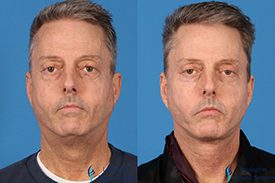#1 Facelift Plastic Surgery in Lexington KY
As we age, it’s common to look in the mirror and see an increasing number of attributes we might like to refine. A few too many wrinkles around the eyes, brow lines that are getting deeper, lips that are thinning out…you know what we mean! Many non-invasive methods of facial rejuvenation are available today, but few can achieve the long-lasting results that a facelift can. If you are a woman or man over the age of 40 who is experiencing the effects of aging and seek a natural looking result similar to the appearance you had five to ten years ago, then perhaps facial rejuvenation surgery is a good option for you. Our goals in reversing the effects of facial aging are to restore firmness, eliminate sagging skin, and to provide a more youthful appearance.
Many patients are concerned that a facelift will leave them looking unnatural or “pulled.” Dr. Gerstle could not agree more that a facelift should leave patients looking more fresh, contoured, and natural rather than like an strange, masked version of their former selves.
The hallmark of a great facelift is when your friends or acquaintances start saying things like, “Wow, you’re really looking great these days!” They will notice that something is different, but it won’t be so dramatic that you look like you’ve had surgery. The result is natural—but noticeable.
To find out more about Facelift surgery at Lexington Plastic Surgery™, PLLC, request a consultation or call our office at (859) 279-2111.
Schedule an appointment in our Lexington, KY office today!
Facelift Surgery Safety
While the facelift procedure is considered to be very safe, it is still a major surgery that carries some risk. If you’ve had prior issues with anesthesia, make sure to discuss this with Dr. Gerstle. In general, you should have good overall health, be a non-smoker or abstinent from nicotine for 6 weeks prior to and following surgery, and be psychologically stable with a realistic view of what facelift surgery can and cannot accomplish.
Certain medications such as blood thinners may need to be paused before the surgery to avoid excess bleeding.
Rare complications of facelift surgery include infection, nerve injury, scarring, prolonged swelling, and temporary or permanent hair loss at the incision sites. Talk with Dr. Gerstle about any concerns you may have. He has performed thousands of facelifts over the course of his career, and he can set your mind at ease, or help you choose a more conservative treatment to start with if you are not ready for a facelift.
The Facelift Procedure
Depending on the extent of the procedure along with other factors, you will likely be put under general anesthesia for the duration of the surgery. In some cases, local anesthesia is also an option.
Dr. Gerstle will make several incisions–again, depending on the nature of your procedure. Typically the incision will be inside and behind the ear. Once the incision sites have been opened, the doctor will begin to remove or redistribute facial fat, remove excess skin, and tighten the muscles that are relevant to the outcomes you’ve discussed. The whole procedure usually takes anywhere from three to five hours.
Most patients can return home later that day. We ask patients who are traveling from out of town to stay for a night at a local hotel so that Dr. Gerstle can examine you at your post-operative appointment the following day, prior to your return home.
Facelift Post Op
After surgery, there will be a thin tube called a drain placed under the skin to collect any fluid that might result from the procedure. Before you return home, you will receive any necessary discharge instructions particular to your case. It is normal for bruising to last for up to three weeks. Dr. Gerstle recommends taking it easy for the first week or two after the surgery, but most patients are ready to return to work in about three weeks. If he placed a drain, it is usually removed the day after surgery. You’ll have a follow-up appointment the day after the surgery, during which time you and Dr. Gerstle will discuss any necessary further appointments or follow-up treatments. Regardless of the timing of your scheduled appointments, Dr. Gerstle is always available for any questions or concerns via his personal cell phone and email.
Self-care is very important during the weeks following your surgery. Ask close friends or family to stop by to check in on you or cook a meal. Podcasts, audio books, or that series you always meant to binge will definitely come in handy! Obviously, always keep your phone and charger nearby along with your medications, gauze and clean towels, and a thermometer to occasionally check for a fever in the days following your surgery.
What is a Facelift?
A facelift (or rhytidectomy) is a surgical procedure that creates a more youthful facial appearance by removal of excess skin from the face and neck, tightening muscles, re-draping the facial skin over the improved underlying facial structures, and adding back fat for lost volume in certain cases.
As a result of the procedure, deep lines and wrinkles are smoothed out, facial contour is sleeker and more defined, droopy excess skin is removed, and muscles that have lost their tone are tightened. Jowls are improved, marionette lines and nasolabial folds between the nose and mouth are partially resolved, and forehead lines are smoothed and tightened. Redundant skin of the neck and double chins are eliminated.
The goal of a facelift is to restore a younger look, not to radically change your face’s appearance. While a facelift can last for up to ten years, you will, of course, continue to age over the lifetime of the procedure’s results and may from time to time desire minor, more focused treatments to maintain the best possible results.
The New You—Working With Dr. Gerstle
We invite you to experience us firsthand by scheduling an appointment to speak with Dr. Gerstle personally about your goals and how we might be able to help you achieve them. We will be happy to provide you with before and after photos of Dr. Gerstle’s long list of very happy patients!
During your confidential consultation with Dr. Gerstle, he will first review your medical history and determine if undergoing facelift surgery is safe for you. If there are any concerns with pre-existing conditions or lifestyle factors, the doctor may order tests to get some objective feedback on where you stand from a clinical perspective. Once Dr. Gerstle gives you the all clear, you can discuss specific areas of concern and get his feedback on the best ways to address them. Dr. Gerstle will then utilize your input to create a computer-generated model using your own photographs to demonstrate the results that you can expect. After this is complete, the two of you can develop the plan to achieve the look you desire.
Facelift FAQ
What is a Facelift?
A facelift uses “redraping” of the skin, tightening of the underlying facial structures, and selective fat removal to turn back the clock on the aging process.
How are facelifts performed?
While there are different methods, a facelift generally consists of surgically going beneath the skin to lift the facial tissues and muscles and then redraping the facial skin over the improved underlying structures to create a more youthful, smoother appearance.
Is the facelift a common procedure?
Yes. There are more than 125,000 facelift surgeries performed every year in the United States.
Who should consider undergoing facelift surgery?
Those who are beginning to experience sagging and would like to improve their appearance will be good candidates for a facelift provided that the skin retains enough elasticity to “bounce back” after the repositioning.
What can I expect on the day of the surgery?
Your procedure will be performed at Lexington Plastic Surgery in the office-based surgical center under general anesthesia. A good rule of thumb is to expect to be in the surgical theater for three to five hours. A friend or family member will need to pick you up afterwards and stay with you that night.
What is the typical recovery time for a facelift?
Many assume that there is a lengthy recovery time after a facelift, but most people will be able to resume many normal activities after just three weeks. You will likely experience some swelling and bruising that can take up to several weeks to resolve. Pain can be managed with prescription or over the counter medications. Other side effects may include headaches, nerve sensations, itchiness, and minor hair loss around the incision site.
Does general anesthesia pose a risk for me?
General anesthesia poses a risk in a small minority of patients. Risk factors include obesity, diabetes, and a personal or family history of adverse reaction to anesthesia.
Can I smoke?
No. You must refrain from smoking for at least six weeks before and after the procedure for the best results. You will be tested for nicotine at your preoperative appointment and the day of surgery.
What procedures can be performed concurrently with a facelift?
While you are already under sedation, your surgeon may take the opportunity to perform other procedures such as eyelid or browlift, facial implants, fat grafting, and laser resurfacing.
What other restrictions will I have after my facelift?
It’s important to stay out of the sun after a facelift. Protecting your skin by wearing a hat for several months (or more) when outdoors is important. Refrain from vigorous exercise for at least two months to protect the incisions, which will take time to heal.
What issues cannot be addressed by a facelift?
Sun damage, uneven pigmentation, and superficial wrinkles will not be affected by facelift surgery. Talk with Dr. Gerstle if you’d like to address these issues in combination with a facelift.
Are the effects of a facelift permanent?
Nothing exists that can stop the aging process, but a facelift can certainly slow it down. You should expect a facelift to last anywhere from seven to ten years. It is not uncommon for patients to decide to have the procedure repeated after that time. Minor maintenance/specialty procedures can be performed during that time if you feel they are necessary.
Is the procedure very painful?
You are likely to experience some discomfort ranging from mild to moderate following a facelift. Compared with other surgeries, the pain associated with a facelift is generally reported to be relatively mild. Prescription narcotics are given for immediate relief, but within a day or two, your pain should be manageable by over the counter pain medication alone. The compression garment and the need to keep the head elevated are minor inconveniences, but the results are well worth it!
Are facelifts risky?
Any surgery carries risk; Dr. Gerstle is highly experienced and will discuss all of the ways that you can mitigate the risk. There is a small chance of side effects such as infection, nerve damage, or hair loss around the incision site. Women can generally hide any small scars that occur behind their ears with their hair.
Locations
Louisville KY
Financing of Facelift Surgery in Lexington, KY
Cherry is a payment plan designed for your health, beauty, and wellness needs and procedures and allows you to make convenient monthly payments.
CareCredit is a healthcare credit card designed for your health and wellness needs that can be used by your entire family. Use it to pay for out-of-pocket expenses not covered by medical insurance. Special financing options are available that you may not be able to get with other cards.
Pay for health and wellness care at over 200,000 enrolled providers across the nation. Once you’ve applied, you can use it again and again at any location that accepts CareCredit. For more information and to apply, please visit CareCredit.com.
![]()
What our patients are saying…
![]() Having a facelift was a big decision. As a director of a large non-profit arts organization, it was important for me to look my best. Dr. Gerstle and his staff put me at ease prior to the procedure. The facelift took 15 years or more off my looks. Dr. Gerstle did an excellent job.
Having a facelift was a big decision. As a director of a large non-profit arts organization, it was important for me to look my best. Dr. Gerstle and his staff put me at ease prior to the procedure. The facelift took 15 years or more off my looks. Dr. Gerstle did an excellent job.![]()
JDM
JDM
JDM
Contact Us




